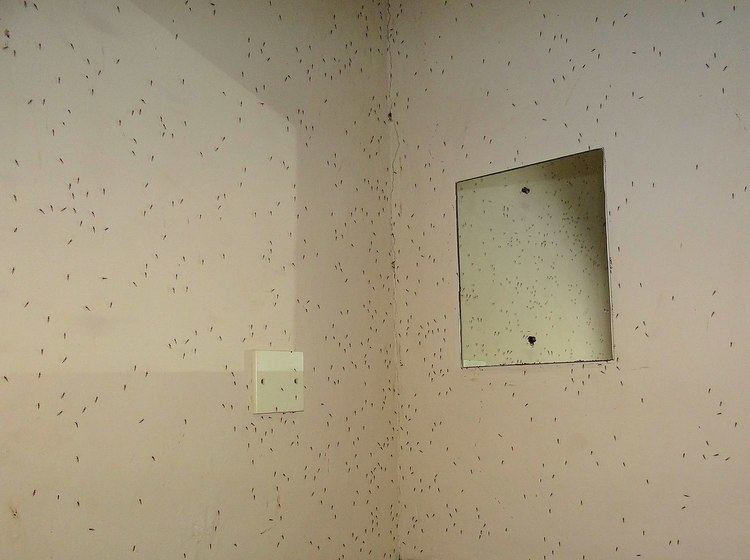 | ||
Indoor residual spraying or IRS is the process of spraying the inside of dwellings with an insecticide to kill mosquitoes that spread malaria. A dilute solution of insecticide is sprayed on the inside walls of certain types of dwellings—those with walls made from porous materials such as mud or wood but not plaster as in city dwellings. Mosquitoes are killed or repelled by the spray, preventing the transmission of the disease. In 2008, 44 countries employed IRS as a malaria control strategy. Several pesticides have historically been used for IRS, the first and most well-known being DDT.
Contents
World Health Organization recommendations
The World Health Organization (WHO) recommends IRS as one of three primary means of malaria control, the others being use of insecticide treated bednets (ITNs) and prompt treatment of confirmed cases with artemisinin-based combination therapies (ACTs). While previously the WHO had recommended IRS only in areas of sporadic malaria transmission, in 2006 it began recommending IRS in areas of endemic, stable transmission as well.
According to the WHO:
Furthermore, for IRS to be effective:
- There must be a high percentage of sprayable surfaces within each dwelling.
- The vector (mosquitos) must feed or rest indoors.
- The targeted vectors must be susceptible (i.e. not resistant) to the insecticide being sprayed.
The WHO further states that "insecticide susceptibility and vector behaviour; safety for humans and the environment; and efficacy and cost-effectiveness" are factors that must be considered when selecting an insecticide for IRS.
Approved insecticides
Currently, the WHO has approved twelve different insecticides for IRS.
Cost effectiveness and efficacy
According to 2010 Cochrane review, IRS is an effective strategy for reducing malaria incidence. It is about as effective as using insecticide treated nets (ITN)s, though ITNs may be a more effective at reducing morbidity in some situations.
Few studies have directly compared the cost effectiveness of IRS directly with other methods of malaria control. A study from 2008 assessed the cost effectiveness of seven African anti-malaria campaigns: two IRS campaigns and five insecticide treated bednet (ITN) distribution campaigns. The authors found that on a cost-per-child-death-averted basis, all were about the same, but the ITN campaigns were slightly more cost effective.
With regard to the cost effectiveness of various pesticides vis-a-vis each other for IRS, historically DDT has been considered the most cost effective, mainly because it lasts longer than alternatives and therefore dwellings can be sprayed less frequently. But actual studies on cost effectiveness are lacking, and none have taken into account the adverse health and environmental effects of DDT or its alternatives. The United Nations Environment Programme (UNEP) concluded in 2008 that "IRS with DDT remains affordable and effective in many situations but, with regard to the direct costs, the relative advantage of DDT vis-à-vis alternative insecticides seems to be diminishing. The contextual evidence base on cost-effectiveness needs strengthening, and the external costs of DDT use vis-à-vis alternative insecticides require a careful assessment."
Residents' opposition to IRS
For IRS to be effective, at least 80% of homes and barns in an area must be sprayed, and if enough residents refuse spraying, the effectiveness of the whole program can be jeopardized. Many residents resist spraying of DDT in particular. This is due to a variety of factors, including its smell and the stains it leaves on the walls. While that stain makes it easier to check whether the room has been sprayed, it causes some villagers to resist the spraying of their homes or to resurface the wall, which eliminates the residual insecticidal effect. Pyrethroid insecticides are reportedly more acceptable since they do not leave visible residues on the walls.
In addition, DDT is not suitable for this type of spraying in Western-style plastered or painted walls, only traditional dwellings with unpainted walls made of mud, sticks, dung, thatch, clay, or cement. As rural areas of South Africa become more prosperous, there is a shift towards Western style housing, leaving fewer homes suitable for DDT spraying, and necessitating the use of alternative insecticides.
Other villagers object to DDT spraying because it does not kill cockroaches or bedbugs; rather, it excites such pests making them more active, so that often the use of another insecticide is additionally required. Pyrethroids such as deltamethrin and lambdacyhalothrin, on the other hand, are more acceptable to residents because they kill these nuisance insects as well as mosquitoes. DDT has also been known to kill beneficial insects, such as wasps that kill caterpillars that, unchecked, destroy thatched roofs.
As a result, Mozambique's chief of infectious disease control, Avertino Barreto, says that resistance to DDT spraying is "homegrown", not due to "pressure from environmentalists". "They only want us to use DDT on poor, rural black people," he says. "So whoever suggests DDT use, I say, 'Fine, I'll start spraying in your house first.'"
Use of DDT
As discussed above, DDT is one of 12 insecticides currently approved by the WHO for use in malaria control. The following table shows recent per country use of DDT for IRS. Unless otherwise noted, data for 2003–07 is from the 2008 Stockholm Convention/UNEP monograph on the current status of DDT, 2008 data is from the WHO's World Malaria Report 2009, and 2009 data is from the 2010 report of the Stockholm Convention's DDT expert group. The World Malaria Report 2009 does not report the amount of DDT used in each country, only whether it is used or not. Accordingly, countries are listed as using 0 or "some" DDT. Use statistics for 2009-2011 are available from a report of Stockholm Convention's DDT Export Group
